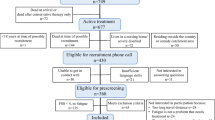Abstract
Fatigue is an important contributor to quality of life in patients who survive aneurysmal subarachnoid hemorrhage (SAH), but the determinants of this fatigue are unclear. We assessed the occurrence of fatigue 1 year after SAH and its relation to physical or cognitive impairment, passive coping, and emotional problems, measured 3 months after SAH. This was a prospective cohort study of 108 patients who visited our SAH outpatient clinic 3 months after SAH and who were living independently in the community 1 year after SAH. Fatigue was evaluated using the Fatigue Severity Scale (FSS). Analysis of variance was used to analyze the data. Fatigue (FSS ≥4) was present in 77 patients (71%). Mean FSS scores were 4.1 (SD 1.6) in the group of patients having ‘neither physical nor cognitive impairment,’ 5.2 (1.4) having ‘either physical or cognitive impairment,’ and 5.9 (0.9) having ‘both physical and cognitive impairments.’ Mean FSS scores were higher in patients scoring high on passive coping (85 vs. 58%; RR 1.46, 95% CI 1.13–1.87), anxiety (84 vs. 55%; RR 1.53, 95% CI 1.17–2.02), or depression (85 vs. 62%; RR 1.36, 95% CI 1.08–1.72) than in patients without these complaints. Relationships between these complaints and FSS scores were higher in patients having neither physical nor cognitive impairments than in patients having physical or cognitive impairments. Fatigue is common after SAH and is related to physical and cognitive impairments. In patients with neither physical nor cognitive impairments, passive coping style and emotional problems are important predictors of fatigue.


Similar content being viewed by others
References
Al-Khindi T, MacDonald RL, Schweizer TA (2010) Cognitive and functional outcome after aneurysmal subarachnoid hemorrhage. Stroke 41:e519–e536
Passier PECA, Visser-Meily JMA, van Zandvoort MJE, Post MWM, Rinkel GJE, van Heugten C (2010) Prevalence and determinants of cognitive complaints after aneurysmal subarachnoid haemorrhage. Cerebrovasc Dis 29:557–563
Visser-Meily JMA, Rhebergen ML, Rinkel GJE, van Zandvoort MJ, Post MWM (2009) Long-term health related quality of life after aneurysmal subarachnoid hemorrhage; relationship with psychological symptoms and personality characteristics. Stroke 40:1526–1529
Ogden JA, Utley T, Mee EW (1997) Neurological and psychosocial outcome 4 to 7 years after subarachnoid hemorrhage. Neurosurgery 41:24–34
Noble AJ, Baisch S, Mendelow AD, Allen L, Kane P, Schenk T (2008) Posttraumatic stress disorder explains reduced quality of life in subarachnoid hemorrhage patients in both the short and long term. Neurosurgery 63:1095–1105
Krupp LB, LaRocca NG, Muir-Nash J, Steinberg AD (1989) The fatigue severity scale. Application to patients with multiple sclerosis and systemic lupus erythematosus. Arch Neurol 46:1121–1123
van Heuven AW, Dorhout Mees SM, Algra A, Rinkel GJE (2008) Validation of a prognostic subarachnoid hemorrhage grading scale derived directly from the glasgow coma scale. Stroke 39:1347–1348
Jennett B, Bond M (1975) Assessment of outcome after severe brain damage. Lancet 1:480–484
Eriksen HR, Olff M, Ursin H (1997) The CODE: a revised battery for coping and defense and its relation to subjective health. Scan J Psychol 38:175–182
Spielberger CD, Gorsuch RL, Lushene PR, Vagg PR, Jacobs AG (1983) Manual for the state-trait anxiety inventory (form Y). Consulting Psychologists Press, Palo Alto
Ploeg van der HM (2000) Handleiding bij de Zelf-beoordelings vragenlijst, een Nederlandse bewerking van de Spielberger Stait-Trait Anxiety Inventory, STAI-DY, Swets en Zeitlinger, Lisse
Beck AT, Ward CH, Mendelson M, Mock J, Erbaugh J (1961) An inventory for measuring depression. Arch Gen Psychiatry 4:561–571
Aben I, Verhey F, Lousberg R, Lodder J, Honig A (2003) Validity of beck depression inventory, hospital anxiety and depression scale, scl-90, and Hamilton depression rating scale as screening instruments for depression in stroke patients. Psychosomatics 43:386–393
Lezak MD, Howieson DB, Loring DW (2004) Neuropsychological assessment, 4th edn. Oxford University Press, New York
Nys GMS, van Zandvoort MJE, van der Worp HB et al (2006) Early cognitive impairment predicts long-term depressive symptoms and quality of life after stroke. J Neurol Sci 247:149–156
Verhage F (1964) Intelligentie en leeftijd: Onderzoek bij Nederlanders van twaalf tot zevenenzeventig jaar (Intelligence and age: study with Dutch people from age 12 to 77). Van Gorcum, Assen
Hellawell DJ, Taylor R, Pentland B (1999) Persisting symptoms and carers’ views of outcome after subarachnoid haemorrhage. Clin Rehabil 13:333–340
Schuiling WJ, Rinkel GJE, Walchenbach R, de Weerd AW (2005) Disorders of sleep and wake in patients after subarachnoid hemorrhage. Stroke 36:578–582
Kreitschmann-Andermahr I, Poll E, Hütter BO, Reineke A, Kristes S, Gilsbach JM (2007) Quality of life and psychiatric sequelae following aneurysmal subarachnoid haemorrhage: does neuroendocrine dysfunction play a role? Clin Endocrin 66:833–837
Klose M, Brennum J, Poulsgaard L, Kosteljanetz M, Wagner A, Feldt-Rasmussen U (2010) Hypopituitarism is uncommon after aneurysmal subarachnoid haemorrhage. Clin Endocrinol 73:95–101
Conflict of interest
None declared.
Author information
Authors and Affiliations
Corresponding author
Rights and permissions
About this article
Cite this article
Passier, P.E.C.A., Post, M.W.M., van Zandvoort, M.J.E. et al. Predicting fatigue 1 year after aneurysmal subarachnoid hemorrhage. J Neurol 258, 1091–1097 (2011). https://doi.org/10.1007/s00415-010-5891-y
Received:
Revised:
Accepted:
Published:
Issue Date:
DOI: https://doi.org/10.1007/s00415-010-5891-y




